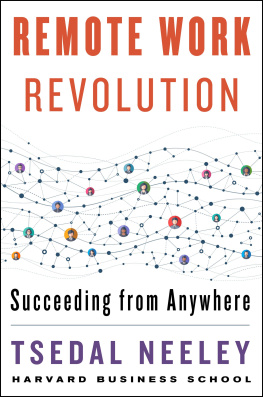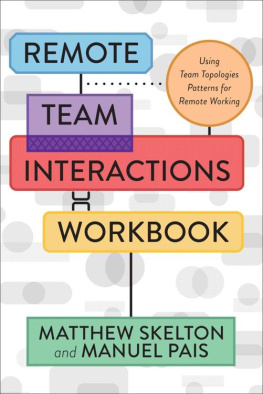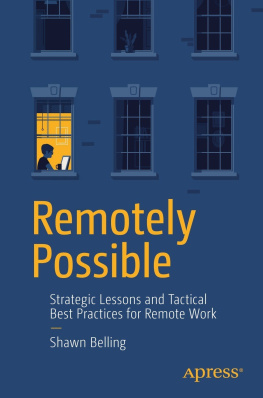Tsedal Neeley - Remote Work Revolution
Here you can read online Tsedal Neeley - Remote Work Revolution full text of the book (entire story) in english for free. Download pdf and epub, get meaning, cover and reviews about this ebook. year: 2021, publisher: Harper Business, genre: Home and family. Description of the work, (preface) as well as reviews are available. Best literature library LitArk.com created for fans of good reading and offers a wide selection of genres:
Romance novel
Science fiction
Adventure
Detective
Science
History
Home and family
Prose
Art
Politics
Computer
Non-fiction
Religion
Business
Children
Humor
Choose a favorite category and find really read worthwhile books. Enjoy immersion in the world of imagination, feel the emotions of the characters or learn something new for yourself, make an fascinating discovery.
- Book:Remote Work Revolution
- Author:
- Publisher:Harper Business
- Genre:
- Year:2021
- Rating:4 / 5
- Favourites:Add to favourites
- Your mark:
- 80
- 1
- 2
- 3
- 4
- 5
Remote Work Revolution: summary, description and annotation
We offer to read an annotation, description, summary or preface (depends on what the author of the book "Remote Work Revolution" wrote himself). If you haven't found the necessary information about the book — write in the comments, we will try to find it.
Remote Work Revolution — read online for free the complete book (whole text) full work
Below is the text of the book, divided by pages. System saving the place of the last page read, allows you to conveniently read the book "Remote Work Revolution" online for free, without having to search again every time where you left off. Put a bookmark, and you can go to the page where you finished reading at any time.
Font size:
Interval:
Bookmark:
To Lawrence, Gabe, and Daniel,
may your worlds always be without borders.
In the first few weeks of 2020, a microscopic agent turned the worlds workforce into remote workers seemingly overnight. With the emergence of COVID-19, employees from China to Qatar, India to Australia, Brazil to Nigeria packed up their offices and set up new workspaces in their homes. Digital tools such as Zoom, Microsoft Teams, Google Chat, and Slack went from useful supplements to the primary enablers for daily interactions with coworkers.
These rapid changes were unprecedented, but the remote work format is not new. Domestic and global companies have had virtual work arrangements for nearly thirty years. Unsurprisingly, technology companies were the first to see the opportunities that remote work offers. The prominent technology company Cisco launched one of the first systematic remote work programs in Silicon Valley in 1993. Employees worked from home or kept flexible hours by using broadband technology to communicate with the main office from any remote location. Cisco reported saving $195 million in 2003, as well as an increase in employee productivity, both of which it attributed at least in part to its remote work arrangements. Also in the late 1990s, Sun Microsystems, still emerging from its startup status, instituted a voluntary virtual work program for 35 percent of its employees as part of its global expansion strategy. Within ten years, Sun saved half a billion dollars by reducing 15 percent of its real estate holdings (2.6 million square feet) in California while adopting geographically dispersed teams to be closer to their markets.
Since then, global teamworkand thus the need to work remotelyhas continued to grow at a staggering rate. What began as a cutting-edge practice of technology companies has become a necessity in nearly every industry. Between 2000 and 2015, U.S. multinational companies alone hired 4.3 million employees domestically versus 6.2 million employees overseasthat means millions of people who need digital technology if they are to communicate with the United States, not to mention the millions of domestic workers who work virtually from home over a distance of a few miles. McKinsey Global Institute predicts that the global labor workforce will reach 3.5 billion people by 2030. Remote work is increasingly here to stay. The future is in remote work.
None of these trends or predictions, however, accounted for a global pandemic that would require the wholesale migration of nearly entire companies to remote work in a matter of weeks. The remote work revolution, long in coming, was accelerated by the sudden and severe coronavirus outbreak. Chances are you are part of the massive transition that has forced companies to rapidly advance their digital footprint including cloud, storage, cybersecurity, and device and tool usages to accommodate their new virtual workforce. These changes have opened up a whole new scope of untold opportunities for people and organizations across the globe.
Now that companies have glimpsed the opportunities that remote work can provide, a portion will permanently maintain some remote days in their routines long-term. In a survey conducted in April 2020 by the Gartner group, 74 percent of 317 companies reported plans to indefinitely adopt more remote work post-COVID-19. Facebook, taking a gradual approach, expects to transition as much as half of its workforce to work from home within ten years. Stockholm-based fashion brand CDLP plans to restructure to locate 50 percent remote workers around the world. JPMorgan Chase, which saw its traders triple their productivity working from home, announced that the company is considering a permanently remote workforce, while UBS already expects as much as one-third of its employees to work remotely on a permanent basis. Groupe PSA, Europes second-largest car manufacturer, announced a new era of agility, in which its nonproduction staff will shift to remote work. The internet company Box expects more than 15 percent of its workforce to work remotely full-time after the pandemic. Similarly, Coinbase, a cryptocurrency exchange, declared it will become a remote-first company, estimating that 2060 percent of the company will work remotely after restrictions are lifted, with more to follow over time. Nielsen Research in New York City will have its three thousand workers work from home most of the week. Nationwide Insurance, observing no loss in employee performance while avoiding operational costs during lockdown, will be transitioning employees at sixteen of its twenty locations into remote workers. Tata Consultancy Services announced that it plans to have about 75 percent of its workforce working remotely by 2025. Other Indian multinationals have also followed suit, as Infosys and HCL Technologies expect 3550 percent or fully half of their employees to work remotely post-pandemic, respectively. The list goes on.
Rather than making plans to incorporate part-time or temporary remote work, Twitter and Square, both headed by CEO Jack Dorsey, made the bold move of giving their workforce the option to work from home forever. Other companies, such as Slack and Shopify, have also responded to the call, announcing that they would extend indefinite remote work arrangements to most of their employees. An upstart company, Culdesac, took it a step further and declared the company was giving up its San Francisco office for a full-on remote work format with the hopes of creating opportunities to create a novel homeless nomadic culture. More are bound to follow.
As you may have discovered, there is no doubt that remote work has benefits. Commute times disappear. Operational costs get slashed. Bloated travel budgets are no longer imperative. Hiring and retaining employees without asking them to relocate from their home countries or domestic cities becomes conceivable, resolving global travel barriers. Astronomical real estate costs that exist in some locations have the potential to get reduced significantly, a welcome solution in an economic downturn. Societal ills like poverty gaps between rural and metropolitan areas might have the opportunity to close while simultaneously creating an untapped labor pool for companies. Gender gaps may shrink as organizations rethink their remote capacities for maternity leave. Gas emissions can decline, having measurable impact on environmental sustainability.
For workers and leaders around the world, however, untrained remote work isnt a panacea. In fact, you may have experienced some or all of the many challenges that are inherent with virtual arrangements. You are not alone if you feel isolated, out of sync, and out of sight. The more time we spend without regular in-person contact with coworkers, the more persistent and urgent questions about bonding, trusting, and alignment become. If your team finds that videoconferences lead to tech exhaustion, questions increase about how to choose the best digital tools to communicate. Or you may be one of the many for whom learning how to best structure tasks to optimize time and to avoid distractions at home is a priority. Agile teams need to transfer tightly coordinated work processes that rely on geographical proximity to a distributed setting. For leaders, how to keep employees motivated and consistently productive while monitoring progress from a distance is a source of concern. Because global teamwork by definition spans multiple geographies and cultures, questions abound about how to ensure that remote workers engage and collaborate effectively across borders. And above all, COVID-19 has brought into sharp relief that all leadership is global precisely because of the interconnected nature of the world; thus, inquiry about preparing foror rapidly responding toglobal events is part and parcel of a remote work revolution.
Font size:
Interval:
Bookmark:
Similar books «Remote Work Revolution»
Look at similar books to Remote Work Revolution. We have selected literature similar in name and meaning in the hope of providing readers with more options to find new, interesting, not yet read works.
Discussion, reviews of the book Remote Work Revolution and just readers' own opinions. Leave your comments, write what you think about the work, its meaning or the main characters. Specify what exactly you liked and what you didn't like, and why you think so.








